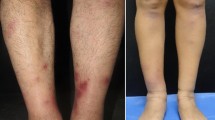Summary
In a prospective study, 73 patients with erysipelas were studied bacteriologically, serologically and clinically. Pathogenic bacteria were isolated from 41% of the patients. Group G streptococci (GGS) were found as frequently as group A streptococci (GAS), in 12.5% and 15% of patients, respectively.Staphylococcus aureus was isolated in 10%, and streptococci groups B, C and D were isolated from one case each. Raised ASO titres were found among patients with GAS and GGS, while a rise in ADNase B titre was found only in patients with GAS. Patients with GGS tended to be older than other patients. Otherwise no clinical differences were noticed. The infection was located to the lower extremity in 68%. Predisposing factors were observed in 44% of the patients, predominantly local circulatory insufficiency and malignancies. In 55% a possible portal of entry was present. GGS seems to be a common cause of erysipelas, especially among patients older than 50 years.
Zusammenfassung
In einer prospektiven Studie wurden 73 Patienten mit Erysipel bakteriologisch, serologisch und klinisch untersucht. Von 41% der Patienten wurden pathogene Bakterien isoliert. Streptokokken der Gruppe G fanden sich bei 12,5% und Streptokokken der Gruppe A bei 15% der Patienten. Bei 10% der Patienten ließ sichStaphylococcus aureus nachweisen, bei je einem Patienten Streptokokken der Gruppen B, C und D. Patienten, von denen Streptokokken der Gruppen A und G isoliert wurden, hatten erhöhte ASO-Titer; eine ADNase B-Titer-Erhöhung fand sich nur bei Patienten mit Streptokokken der Gruppe A. Streptokokken der Gruppe G traten eher bei älteren Patienten auf. Klinische Unterschiede wurden nicht festgestellt. Bei 68% der Fälle war die Infektion an einer unteren Extremität lokalisiert. Prädisponierende Faktoren bestanden bei 44% der Patienten, vor allem lokale Kreislauf-Insuffizienz und Malignome. In 55% der Fälle fand sich eine für die Infektion in Frage kommende Erregereintrittspforte. Vor allem bei Patienten über 50 Jahre sind offensichtlich nicht selten Streptokokken der Gruppe G ursächlich an der Entstehung eines Erysipels beteiligt.
Similar content being viewed by others
Literature
Binnick, A. N., Klein, R. B., Baughman, R. D. Recurrent erysipelas caused by group B streptococcus organisms. Arch. Dermatol. 116 (1980) 798–799.
Hare, R. The classification of hemolytic streptococci from the nose and throat of normal human beings by means of precipitin and biochemical tests. J. Path. Bact. 41 (1935) 499–512.
Konopik, J. Das Problem des rezidivierenden Erysipels. Hautarzt 16 (1965) 158–163.
Shama, S., Calandra, G. B. Atypical erysipelas caused by group G streptococci in a patient with cured Hodgkin's disease. Arch. Dermatol. 118 (1982) 934–936.
Milstein, P., Gleckman, R. Pneumococcal erysipelas. Am. J. Med. 59 (1975) 293–296.
Burton, I. B., Sosin, A. Erysipelatous skin necrosis in a newborn infant caused by lethal toxin of staphylococcic origin. Pediatrics 18 (1956) 249–253.
Hagen, Å.-G., Lassen, J., Nordbö Berge, L. Erysipelas-like disease caused byYersinia enterocolitica. Scand. J. Infect. Dis. 6 (1974) 101–102.
Duma, R. J., Weinberg, A. N., Medrek, T. F., Kunz, L. J. Streptococcal infections. A bacteriologic and clinical study of streptococcal bacteremia. Medicine (Baltimore) 48 (1969) 87–127.
Feingold, D. S., Stagg, N. L., Kunz, L. J. Extrarespiratory streptococcal infections. Importance of the various serologic groups. N. Engl. J. Med. 275 (1966) 356–361.
Lam, K., Bayer, A. S. Serious infections due to group G streptococci. Report of 15 cases within vitro-in vivo correlations. Am. J. Med. 75 (1983) 561–570.
Parker, M. T., Ball, L. C. Streptococci and aerococci associated with systemic infection in man. J. Med. Microbiol. 9 (1976) 275–302.
De Waal, H. L. A study of the serological types of hemolytic streptococci in relation to the epidemiology of scarlatina and other infections due to these organisms. J. Hyg. 41 (1941) 65–99.
Fast, A. Determination of anti-streptolysin O by reversed single radial immunodiffusion. Acta. Path. Microbiol. Scand. Sect. B. 82 (1974) 715–718.
Keefer, S. K., Spink, W. W. Studies of hemolytic streptococcal infection. I. Factors influencing the outcome of erysipelas. J. Clin. Invest. 15 (1936) 17–19.
Ronnen, M., Suster, S., Schewach-Millet, M., Modan, M. Erysipelas. Changing faces. Int. J. Dermatol. 24 (1985) 169–172.
Auckenthaler, R., Hermans, P. E., Washington II, J. A. Group G streptococcal bacteremia: clinical study and review of the literature. Rev. Inf. Dis. 5 (1983) 196–204.
Bayer, A. S., Chow, A. W., Anthony, B. F., Guze, L. B. Serious infections in adults due to group B streptococci. Clinical and serotypic characterization. Am. J. Med. 61 (1976) 498–503.
Erdman, S. Erysipelas. Clinical observation on 800 cases, including 95 treated by bacterial vaccine and 20 treated by phylacogen. J.A.M.A. 61 (1913) 2048–2051.
Leppard, B. J., Seal, D. V., Colman, G., Hallas, G. The value of bacteriology and serology in the diagnosis of cellulitis and erysipelas. Br. J. Dermatol. 112 (1985) 559–567.
Todd, E. W. The streptolysins of various groups and types of haemolytic streptococci; A serological investigation. J. Hyg. 39 (1939) 1–11.
Ferrieri, P. Immune responses to non-group A streptococci of the throat. In:Read, S. E., Zabriskie, J. B. (eds.). Streptococcal diseases and the immune response. Academic Press, New York 1980, pp. 205–210.
Weinstein, L., Taso, C. C. Effect of treatment on development of anti-streptolysin in patients with scarlet fever. Proc. Soc. Exp. Biol. Med. 63 (1946) 449–450.
Wannamaker, L. W., Ayoub, E. M. Antibody titers in rheumatic fever. Circulation 21 (1960) 598–614.
Author information
Authors and Affiliations
Rights and permissions
About this article
Cite this article
Hugo-Persson, M., Norlin, K. Erysipelas and group G streptococci. Infection 15, 184–187 (1987). https://doi.org/10.1007/BF01646044
Received:
Accepted:
Issue Date:
DOI: https://doi.org/10.1007/BF01646044




